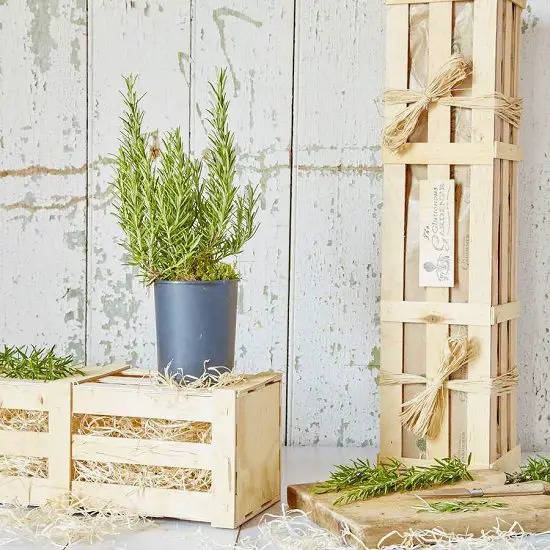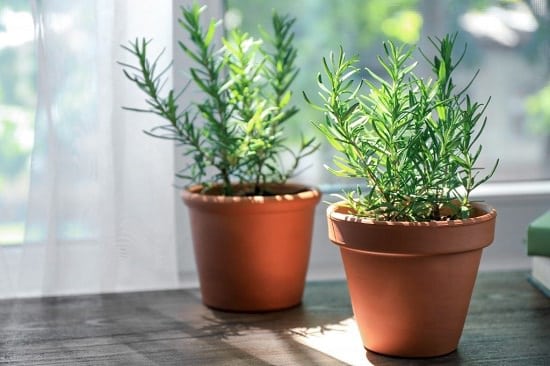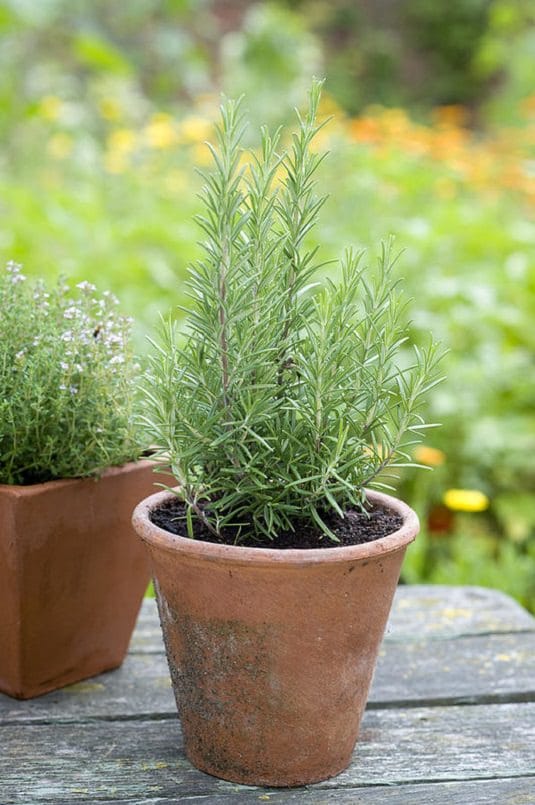Growing Rosemary in Pots will give you access to fresh sprigs of this culinary and medicinal herb all year round.
You don’t need a lot of space to grow herbs and vegetables. A few pots, a small balcony or patio, and several hours of good sunlight are the most basic requirements. Planting rosemary is not much different, and you can even grow it indoors if you know these essential Rosemary Plant Care Tips in this article.
Botanical Name: Rosmarinus officinalis
USDA Zones: 6-11
Soil pH: 6-8, grows best in neutral soil
Types of Rosemary

Basically, there are two types of rosemary, and all the varieties fall between them. There are shrub-like upright varieties that can grow up to 5-6 feet tall, and then there are prostrate varieties that are low growing and spread around, they usually don’t rise above one foot tall.
In containers, you can grow any type of rosemary variety. Low growing, trailing cultivars in large hanging baskets or as a groundcover and those bush-like, taller ones in medium to big sized pots. Apart from the ornamental purposes, if your main motive is flavor, upright varieties are better.
Semi-upright rosemary varieties that don’t grow above 2-3 feet tall are easy to manage. However, that doesn’t mean you can’t plant tall cultivars. You can easily keep them at the desired height by regular trimming.
A few of our Favorite Rosemary Varieties:
You’ll also need to look out for cold-hardy rosemary types as this herb prefers a warm Mediterranean climate. The two best varieties are “Arp” and “Hill Hardy.”
Creeping Rosemary: Rosmarinus Officinalis ‘Prostratus’ is a perennial creeping variety. Perfect for containers and hanging baskets, this trailing herb doesn’t make over 2 feet tall.
Joyce de Baggio: Also known as golden rosemary, it’s compact and small. The leaf color changes to a beautiful bright yellow shade with the season.
Pinkie: An excellent companion plant for roses, it bears pink flowers.
Some of the most flavored varieties which are best for cooking are Miss Jessup, Tuscan Blue, and Spice Island.
Choosing a Pot
Pot size depends on the type of rosemary you’re growing. You can grow trailing rosemary varieties in smaller pots, whereas, upright rosemary cultivars require medium to large pots. You can begin with 6-8 inches deep pot and once the plant outgrows it, shift it to a 12 inches deep pot. While any pot made from any material is fine for planting rosemary, terra-cotta pots are slightly better as they readily absorb excess moisture in the soil.
How to Propagate Rosemary
There are two ways to propagate rosemary. One is from seeds, and the other is from cuttings.
Propagation from Seeds:
Growing rosemary from seeds should be your last idea for its propagation because of the hassle you have to go through. Rosemary can take a lot of time to grow to a size where it can be harvested. Also, the germination time and success rate will be low.
Propagation From Cuttings:
Growing rosemary from cuttings is an easy way to multiply this herb. First of all, lookout for a healthy rosemary plant and select a few young non-flowering shoots. The cuttings should be about 3-4 inches in length.
Use a sharp tool to remove the bottom sets of leaves, except from the top 1½ inches of the stems before dipping their end in a rooting hormone. That’s it! Your rosemary cuttings are ready for potting. Check out this article to learn more.
Tip: If you’re growing only one or two plants, it’s better to buy the transplants from a nearby nursery, instead of propagating them from seeds or cuttings.
Requirements for Growing Rosemary in Pots
Position
Select a spot that receives at least six hours of direct sun for placing the pot. In a tropical climate, pick a position where protection from the afternoon sun is possible. If you’re growing rosemary indoors, choose a south-facing window where it’ll get ample sunlight.
Also Read: 24 Indoor Herb Garden Ideas
Watering
Throughout the growing season, water the plant thoroughly but let the top two inches of soil to dry out between watering cycles. As rosemary does not like to sit in water and moist soil, you’ll need to avoid overwatering. These overwatering tips will help you!
Soil
Avoid using regular garden soil for growing rosemary. You can make your own soilless potting mix or use a commercial one. The growing medium should be light, fluffy, and well-drained. Also, the addition of twenty percent compost or aged manure at the time of planting ensures optimum growth.
Rosemary Plant Care
Fertilizer
Rosemary is not a heavy feeder, and on the ground, it can grow easily in poor soils. However, when you’re learning how to grow rosemary in a pot, it’s important to note that you’ll need to feed this herb.
Applying a slow-release balanced fertilizer at the beginning of the growing season will give a good start to your plant. Instead of that, you can also disperse a handful of compost or well-rotted manure time to time on the top surface of the soil. If you don’t mind the odor, fish emulsion is also a healthy organic option to give a quick nitrogen boost.
You can also feed with half-strength balanced liquid fertilizers like 10-10-10 between the duration of every 3-4 weeks, depending on how well your plant is doing. Remember, it’s not mandatory to fertilize regularly unless it’s required as overfertilization reduces the essential oil content in herbs like rosemary.
Weather
Rosemary can grow year-round as an evergreen herb in moderate climates, where winters are not very harsh. It can tolerate some frost as well, but it’s better to transfer it indoors once the temperature starts to drop below 30 F (0 C). Keep it near a West or South-facing window so that it can still receive the sunlight. You can also opt for grow lights and grow tents.
Pests and Diseases
Some common garden pests such as whiteflies, scale, mealybugs, and spider mites can be detrimental for rosemary. Spider mites are common in dry and warm weather, especially when you grow plants indoors. Here’re some ways to get rid of them.
Powdery mildew is another thing you should look out, especially in humid regions. Provide good air circulation to protect rosemary from such ailments. Another common problem is root rot. With good drainage and proper watering practice, you can avoid this!
Also Read: How to Improve Air Circulation for Indoor Plants
Pruning Rosemary
When the plant is young and grows about 4-5 inches, pinch off the tips with fingernails or shears, this will boost the side growth and make it bushier. To make it even better, afterward, when the plant becomes 8-10 inches tall, remove the top growth again just above the leaf node, saving the emerging lateral buds. These lateral buds will grow and give the plant a fuller appearance.
You can do light and regular pruning time to time throughout the growing season, up until 4-6 weeks before the first frost. Pinch off the top 2-3 inches of the plant’s outermost stems when you harvest it to encourage new growth. The snipped off parts can be used in cooking, herbal teas, and infused oils. You can also propagate new rosemary plants from them.
Avoid this pinching or pruning in late fall and winter, when the plant is hardening off to protect itself in winter. However, you can continue this pinching and harvesting year-round if you’re growing rosemary indoors or live in a climate where winter is not so harsh.
Also Read: How to Grow Oregano in Pots
Pruning Old and Large Rosemary Plants
Pruning rosemary is the best way to ensure bushier plant growth with the desired shape, size, and flavor. Do this every year when you see some active growth at the beginning of the growing season, i.e., early spring or mid-spring. Remove all the dead, damaged, and crossing stems to improve air circulation and to give shape to the plant you desire.
As rosemary is a woody herb, it also requires hard pruning in a few years’ intervals, only when it’s overgrown or leggy to rejuvenate the new growth. For this, cut back no more than one-third of the active growth of the plant in the early spring.
If your rosemary plant is suffering from the winter damage or fungal infection, prune the damaged, dead, and crossing stems until the living wood or first set of healthy green leaves appear, after the winter is over. To learn more, check out our article on how to prune herbs.
Is Rosemary a Toxic Plant for Cats? Find out here
Harvesting
You can harvest the most flavored rosemary when the new growth is neither soft nor turned woody. For this cut off the part of stem above the woody part. Too much harvest can cause irreversible damage to the plant. Not more than 25 percent of an overall plant should be taken at one time.
Also Read: How to Harvest Herbs
Rosemary Benefits
Like oregano, thyme, basil, and lavender, it is also a member of the mint family and one of the most popular Mediterranean herbs. The needle-like leaves of rosemary not only serve the ornamental purpose but also add flavor to various recipes. It can improve digestion and blood circulation when added in soups, salads, and stews. It also goes well with meat and fish dishes.
Iron, calcium, and vitamin B-6 are also found in abundance in rosemary. It’s also a rich source of antioxidants and anti-inflammatory compounds. And, according to recent studies and research, sniffing rosemary can improve your memory and cognition and help in depression and anxiety. Learn more about it here!







I already have basil and thyme, I’ll start with rosemary now. Thank you for the imformation.
I have three rosemary plants that are very large. Can I trim more than 1/3 of the plants and still keep them healthy. I have never fertilized any of the three. I also have a smaller one this growing on the south of my house, it is only about three years old. I plan to remove it completely. It does not have a straight body.